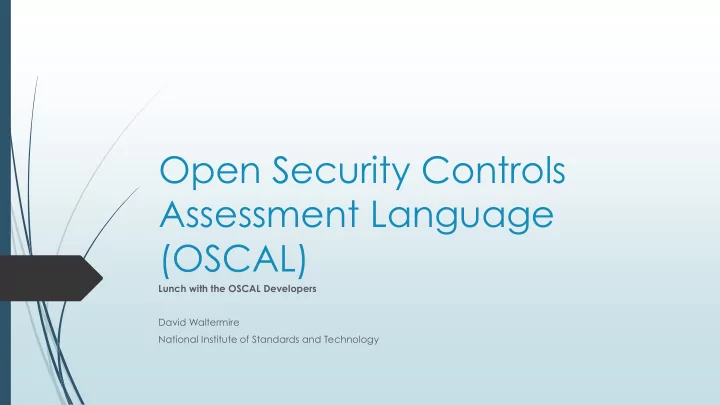

Open Security Controls Assessment Language (OSCAL) Lunch with the OSCAL Developers David Waltermire National Institute of Standards and Technology
Teleconference Overview 2 Ground Rules OSCAL Status Summary (5 minutes) Issues Needing Help from the Community Question and Answer / Discussion Submitted questions will be discussed The floor will be open for new questions and live discussion
OSCAL Lunch with the Developers 3 Purpose: Facilitate an open, ongoing dialog with the OSCAL developer and user communities to promote increased use of the OSCAL models Goals: Provide up-to-date status of the OSCAL project development activities Answer questions about implementing and using the OSCAL models, and around development of OSCAL model-based content Review development priorities and adjust priorities based on community input Help the OSCAL community identify development needs
Ground Rules 4 Keep the discussion respectful Using welcoming and inclusive language Being respectful of differing viewpoints and experiences Gracefully accepting constructive criticism Focusing on what is best for the community Wait for one speaker to finish before speaking - one speaker at a time Speak from your own experience instead of generalizing ("I" instead of "they," "we," and "you"). Do not be afraid to respectfully challenge one another by asking questions -- focus on ideas. The goal is not to always to agree -- it is to gain a deeper understanding.
OSCAL Version 1 Milestones 5 Milestone Focus Sprints Status Date Milestone 1 Catalog and Profile Models 1 to 21 Completed 6/15/2019 Milestone 2 System Security Plan (SSP) Model 6 to 23 Completed 10/1/2019 Milestone 3 Component Definition Model 6 to ~28 In Progress ~May 2020 Full Release Development of a web-based 24 to ~33 In Progress August 2020 specification Ongoing Minor and bugfix releases as Additional Planned Ongoing Maintenance needed Sprints Current Sprint: 28 (https://github.com/usnistgov/OSCAL/projects/27)
Review of Current/Completed Work 6 On Github: https://github.com/usnistgov/OSCAL
Other Development Efforts: 7 Java Code Generation A tool that generates Java classes and Metaschema serializers/deserializers based on a Metaschema definitions Generated code can read/write valid XML, JSON, and YAML content based on Code Generator Metaschema generated XML and JSON schema Reading and writing XML, JSON and YAML now working Generated Java Classes Working on a Maven plugin to auto generate code Will be used to create an OSCAL Java library https://github.com/david-waltermire- nist/metaschema/tree/java- metaschema/toolchains/java XML JSON YAML
Other Development Efforts 8 Developing XSL templates that generate: SP 800-53 style control listing in HTML and PDF An SSP based on a SP 800-18 template in HTML and PDF Developing OSCAL Command Line Tools Validation and conversion of OSCAL content Comparison of OSCAL content (e.g., SP 800-53 rev4 vs rev5)
Help Needed 9 Please review pull requests and comment on issues you are interested in.
Discussion 10 Goals: Establish a robust, engaged OSCAL development community. Enable the community to assist other community members. Promote adoption of the OSCAL data formats in GRC and assessment tooling. What barriers can we break down to promote these goals? Are there other things we should be focusing on?
Open Floor 11 What would you like to discuss? What questions do you have?
Thank you 12 OSCAL Repository: https://github.com/usnistgov/OSCAL Next Lunch with Devs: Project Website: April 9, 2020 https://www.nist.gov/oscal 12:00 Noon EST (5:00 PM UTC) How to Contribute: https://pages.nist.gov/OSCAL/contribute/ Contact Us: oscal@nist.gov
Backup Slides 13
OSCAL Layers & Models 14 OSCAL is architected in layers The lowest layer is foundational Each higher layer builds on Assessment Planned Results layer(s) below it Layer Building up from foundation Assessment Planned OSCAL development is following Layer this bottom up approach System Security Plan Model Implementation Allows lower layers to be used, Layer while higher layers are Component Model developed Lower layers can be enhanced Profile Profile Model Layer based on high-layer information needs Catalog Ensures that data provided in Catalog Model Layer lower layers can be used to meet the information needs in higher layers
Recommend
More recommend